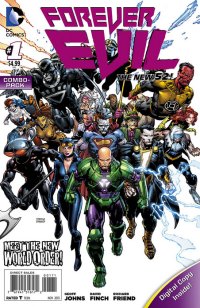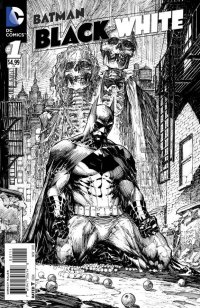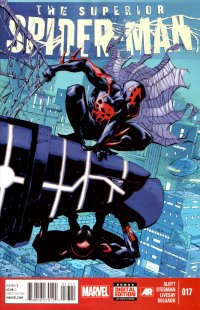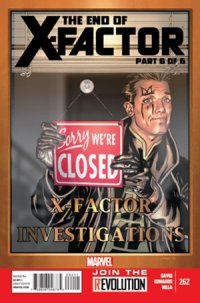Forever Evil #1 ($3.99, DC)
by D.S. Randlett (@dsrandlett)
It’s hard being a DC Comics fan these days. That’s something that I’ve always been, and probably something I always will be, but more and more it’s like watching a good friend suffer from dementia. They are obviously trying to create a constantly cohesive DCU in an effort to sell more books. You want the whole story, right? At the same time, they’re trying to live up to the legacy of the classic runs on these characters, many of which took place in the pre-Crisis era when continuity wasn’t such a concern for comic book lines. I don’t think it’s an accident that the best books that the company is putting out right now are the ones taking place more or less in their own bubbles. Wonder Woman and Green Arrow are superb titles that everyone should be reading, and the anthology-esque title Adventures of Superman has yet to hit a low point because, by virtue of their isolation, these books are free to explore the values that their respective characters represent. Not that the soap opera stuff can’t be good, but it’s really not what the company’s most enduring characters are best suited for.
And so, I checked out of Trinity War. I didn’t do so out of some principled stand. I was just exhausted with the unrelenting rhythm of the line’s ceaseless need to simply advance its plot. For a perfect example of what I mean, just look back to Superman and Wonder Woman’s first kiss. Now, I’m not opposed to a relationship between those two characters in the least, but it just comes out of nowhere, and not once has it been used for a genuinely human moment. The relationship is just another cog in the Justice League machine, another step in the path on the way to Geoff Johns’ next big event story. This pattern more or less worked for Green Lantern until Johns hobbled across the finish line in his run on that title, but his Justice League has limped from the start.
But what he has been good at lately are beginnings. Justice League of America had a strong start, and so does this next DC event, Forever Evil. We pick up right after the events of Trinity War, which saw the arrival of the New 52 Injustice Society. Thankfully, knowledge of Trinity War isn’t needed to understand what’s going on here: the heroes are gone, and the Injustice Society is on track to conquer Earth 1. For the first time in Johns’ Justice League saga, there’s a feeling of momentum and change in the air as the DCU’s status quo is upended. There’s a global power outage, the Injustice Society takes over the communications networks, and, most importantly, they recruit the supervillains of Earth 1.
Except for Lex Luthor. This character has had a rough go of it in the New 52. Morrison wrote him as a genius contractor with villainous potential, Scott Lobdell writes him as a mad criminal scientist with tics stolen from Heath Ledger’s Joker portrayal, and Scott Snyder hasn’t exactly played his hand yet. Johns finally zeroes in on what makes the character work here. Once again, we have Luthor the corporate titan, which is a necessary element of the character in the modern era. In doing so, Johns finds that strange zone that the character at his best inhabits. Luthor should be acting out of a commingling of ego and principal. The thing that makes Luthor great is not that he’s good at doing the wrong thing (even though he certainly is), but that sometimes he does the right thing, and this series seems poised to open the door for a deeper characterization of Lex Luthor than has been available for the past year and change.
But then, I have a hard time trusting Johns on that score. Something that Geoff Johns is good at is the initial boat rocking. He is extraordinarily adept at finding ways to challenge his characters, but has gotten increasingly weak at framing his characters’ responses in ways that make any sense. One of the reasons we keep reading superhero comics is that when they’re done right, underneath the laser beams, biceps, and cleavage, we are party to arguments over what constitutes a good life. Good arguments shift, change, and twist. Johns has proven himself victim to the inertia of superhero storytelling where good “wins” in the end. But what we want to see isn’t good winning. We want to see good justify itself. Perhaps by focusing on villains, Johns will force himself to justify his characters? Or will we merely see the steady march of “less bad” winning? I want to be convinced. But, as tempting as it is to give in to this first issue, I am reticent.
David Finch’s art isn’t as strong as it has been on Justice League of America. Some of his images look fantastic (the final page is simplistic, but extremely evocative), but for the most part his lines show the signs of a rush job. That’s not to say that Forever Evil looks downright awful, but you can tell when it hasn’t received the due amount of care.
Forever Evil is a nice bit of something fun with the hints of something a bit stronger beneath the surface, but if you’re at all fed up with Geoff Johns or DC’s direction, it probably won’t be the thing to put you at ease.
Rating: 




Out of a Possible 5 Stars
 God Is Dead #1 of 6 (Avatar, $3.99)
God Is Dead #1 of 6 (Avatar, $3.99)
By Jeb D.
Given the amount of time he’s spent chronicling the lives , conflicts, and deaths of fantastically colorful godlike beings for Marvel, you might have thought that, in a new creator-owned comic called God Is Dead, Jonathan Hickman would take the opportunity to present a somewhat more grounded, cerebral take on the notion of Divinity. What we appear to have, so far, though, is… well, a story of the lives, conflicts, and deaths of some fantastically colorful godlike beings, who differ from the Avengers or Thanos primarily by being the bases of some of the world’s most ancient cultures, as opposed to being the bases of billion-dollar movie franchises.
There’s not a lot to spoil about this first issue, since it’s basically laying out the premise you read in the solicitation: a series of devastating natural disasters turns out to have been the reawakening of the gods of the myths and legends of the Greeks, Norsemen, Egyptians, pre-Colombian Americans, and Hindi, who have returned to earth. Early on, Zeus makes the case that it’s man’s failed stewardship that has forced the return: “We bequeathed this world to men, and now it’s in a worse state of affairs than the one I left.” Odin, on the other hand, has a somewhat different take on Midgard: “This bitch is ripe and wet and spread wide open for us— Let’s take her.”
Besides these mythic titans, we’re introduced to their human opponents: some bloodthirsty U.S. military officers (who are all likely fucked before things are over), and an “underground resistance” of gunslingers and scientists (one of whom is drawn to resemble Albert Einstein, for what I hope is some kind of time-travel subplot, and not just a lazy depiction of the only scientist most people will recognize), who might possibly develop personalities as we go forward.
The script is by Hickman and Mike Costa, and not knowing how much each contributed, it’s hard to be certain if the surface glibness of the concept is something that Hickman might have fleshed out, given more time to work through it on his own. That’s not to say that there’s no intelligence at work here, but the points about the oppressive nature of organized religion aren’t exactly new, and in a six-issue miniseries, they’re unlikely to be developed much further, to make room for the giant-god ‘splode that appears to be on the way. It’s possible that the Christian Holy Trinity will put in an appearance (I doubt it’s coincidence that each of the other pantheons is represented by just three characters), but with Hickman’s deserved reputation for careful planning, over the course of six issues, I’m not expecting needle-scratching plot swerves; Hickman really hasn’t left himself much time or space to work with here. It’s not that the story doesn’t have the potential to be interesting, but this first issue doesn’t hint at much beyond what’s inherent in the premise. There’s also exactly one actual joke in the book and it’s basically a riff on a classic Simpsons moment.
The art by Di Amorim is clean and well-defined, with colorist Junamar adding vivid life to the pantheon of deities. It’s pretty static, though, with bland faces and stiff movement sequences; even the scenes of natural destruction are handled perfunctorily: they’re all tossed off on one page. Lest anyone forget that this is an Avatar comic, though, there is one gory sequence of a human sacrifice.
When I was a young’un, I discovered James Blish’s 2-part novel, Black Easter and The Day After Judgement, in which Satan is turned loose upon a world that has abandoned, or been abandoned by, God, and discovers that the responsibility for the portioning of good and evil is too much even for his dark shoulders. Profound and all that, with Satan given a long, Miltonian exegesis; but at that age, all that metaphysical shit went over my head: what excited me were the sections where the US military takes on the forces of demons and darkness. But at this point in my life, even more than seeing giant gods go toe-to-toe with American nukes, I think I’d prefer a bit more of that metaphysical shit in my reading. I’m probably adding a half star to this rating based on the hope that Hickman has some of that up his sleeve for future issues.
Rating: 




Out of a Possible 5 Stars
Adam Drinks the Kool-Aid Two-For-One Special
Batman Black and White #1 (DC, $4.99)
The Superior Spider-Man #17 (Marvel, $3.99)
By Adam X. Smith
Previously on Thor’s Comic Column…
I started by reviewing a series I didn’t care about, continued by bitching about how anthology issues needn’t be bullshit on chips, and called out Grant Morrison on how shiny his head is. Phil Urich was outed as Hobgoblin, the Superior Spider-Man continued being an insufferable arsehole, and Green Goblin got one more recruit to his sewer dwelling army of Gobshites. Batman spent twenty pages trying to decide whether to continue to fund the antics of Batman Incorporated, presumably by watching videos of them on Youtube. Will people realise that all is not as it seems with the new and definitely-not-improved Peter Parker? Will the Gobshite Army rain blood on New York? Will DC break the habit of a generation by presenting me with a mainstream comic that doesn’t suck?
Well, this is damn well more like it, DC! When I hear the words “Batman Black and White” in a sentence I expect a level of quality that the rank and file don’t always deliver, and with good reason – the previous iterations of the series, mostly back-up stories in Gotham Knights, attract the cream of the Bat-crop when it comes to writers and artists. Hallelujah, then, that this relaunch issue gets off to a brilliant start (no sarcasm this time) by having not just a superior gloss cover that does Marc Silvestri’s cover image justice that regular paper just can’t, but the added touch of a frontispiece spread by Phil Noto, complete with the dedication “For Archie Goodwin” at the bottom, seals the deal: last week’s Batman Inc. Special was a placeholder, a box-ticker; this is where the real good stuff is, and though the book is slightly shy on the rock-star names you’d immediately associate with it, what it does have in spades is creativity and simplicity.
When you’re handed a brief that presumably reads “tell a Batman story in eight pages, except with no colour”, it’s hard to imagine how you could cock that up, but then the proof is most certainly in the pudding: under the guiding light of editor Mark Chiarello, the concept that was dismissed as a non-starter in 1996 has gone on to attract not only solid old hands but given new and emergent talent a spotlight. And if the emphasis on the artwork does seem a little troubling – my big gripe last week was the flimsiness of the stories – then rest assured that is not a problem here. In Black and White #1 we get possibly the best of all possible Bat-possibilities. Wow, what a mouthful.
Chip Kidd and Michael Cho start with a beautiful tribute to Dick Sprang with “Don’t Know Where, Don’t Know When”, which takes the unorthodox story tack of focusing mainly on Robin, who spends most of the night waiting patiently on a rooftop for Batman to rendezvous with him. The story plays out as an ode to the Golden Age Dynamic Duo, with the precocious but vulnerable Robin standing in for every child who’s gotten lost and needed the aid of a certain big blue Boy Scout to help them. Not since Darwyn Cooke has something embodied the integrity and simplicity of those halcyon days of comics with all the craft and innovation of the current generation.
Then, from Bat-legend Neal Adams on both writing and art duties, we get a tribute to Winsor ‘Silas’ McCay’s Dream of the Rarebit Fiend strip entitled “Batman Zombie”, which renders Batman as a rotting yet still living and sentient corpse, powerless to do anything but wheeze pitifully at the evils surrounding him, confronted by his own failure to combat either his regular rogues gallery or the more banal societal evils his theatrics tend to overlook. Naturally, it’s all a fever dream brought on by too much cheese on toast, but the effect it has on Bruce Wayne when he wakes up marks this out as a companion to Adams’ 1970s work with its focus on heavy real-world politics. What could have dragged an expert display of draughtsmanship into the arena of Aesopian fables and hand-wringing liberal guilt is a self-assuredness that comes from years as the definitive artist of the naturalist movement in comics and a command of storytelling that comes from that same experience.
Say, you like Harley Quinn and Poison Ivy together, right? Of course you do, and Maris Wicks and Joe Quinones give us a humdinger of a Harley and Ivy story involving fast food gone awry. Does the cel-shaded artwork come off as a little too smoothed out and plasticised? Just a little. Is the writing and overall presentation akin to a back-up story in a particularly weak spin-off comic from the Nineties’ cartoon show? Regrettably, yeah. But you know what, ladies and germs? I’ll take Harley and Ivy in full TAS mode (with costumes thankfully intact), with all the flimsiness that comes with it, over whatever DC are choosing to do with them at the moment any day.
Let the record show that the reason I purchased this comic was when I got wind that Sean Murphy of Punk Rock Jesus and The Wake was doing a Batman strip with John Arcudi, a writer I know pretty much only from his work with Mike Mignola’s B.P.R.D. stable at Dark Horse. That, however, was enough to make me call dibs, and his story of Bruce Wayne as a petrol-head control freak when he’s not in the cape and cowl – and a vehicular menace when he is – adds colour and wit to a character who comes off as bland and lifeless in lesser hands. There’s a playfulness in his eyes that is peculiar in its rarity when dismantling the Batmobile in an attempt to make it the most powerful drag-racer since David Carradine first donned black latex bondage gear and called himself Frankenstein. Context is everything.
Finally, wrapping it all up is a psychological noir story from Howard Mackie and Chris Samnee called “Mind Games”. If it’s a little bit of a whimper rather than a bang at the end of such an impressive offering, the promise of stories from the likes of Dan Didio and J.G. Jones, Rafael Albuquerque, Jeff Lemire and Michael Uslan is the spoonful of sugar that helps the medicine go down.
So. Now the medicine.
 Superior Spider-Man continues its long history of not giving a shit whether the audience, and in this case me, are long-running fans or Johnny-Come-Latelies, and proceeds to just keep on rolling. Whilst I found #16 to be a bit of a learning curve – I knew virtually nothing about the series other than (as previously explained by everyone and their dog to everyone except the occupants of the Marvel universe) the fact that Peter Parker has mind-swapped with Otto Octavius – I was pleasantly surprised to learn that #17 would make its predecessor look like “Baby’s First Spidey-Comic” by comparison.
Superior Spider-Man continues its long history of not giving a shit whether the audience, and in this case me, are long-running fans or Johnny-Come-Latelies, and proceeds to just keep on rolling. Whilst I found #16 to be a bit of a learning curve – I knew virtually nothing about the series other than (as previously explained by everyone and their dog to everyone except the occupants of the Marvel universe) the fact that Peter Parker has mind-swapped with Otto Octavius – I was pleasantly surprised to learn that #17 would make its predecessor look like “Baby’s First Spidey-Comic” by comparison.
Yes, we not only get all the drama that is inherent in the current Superior Spidey run, and I finally get a bunch of time spent with Otto-as-Peter out of costume at Horizon Labs (a job I had no idea he had) with a bunch of co-workers who all seem to be aware he “works” for Spider-Man (none of whom I know either) but haven’t pieced together that he is Spider-Man. We get all that and thrown in on top we get a completely different B-plot featuring (wait for it) Miguel O’Hara aka Spider-Man 2099. Seems Future-Spidey has been transported to the present day – sorry, the Heroic Age by a series of reality-warping tears in the fabric of timespace that are popping up in Nueva York (apparently in the future everyone’s a little bit Latin American), and is trying to prevent a catastrophic time paradox, presumably by creating an even bigger one by showing up with his silly day-glo costume and sparking a wave of quasi-futuristic Nineties retro fashion a century too early.
I’m not going to summarise any more of the plot than that because there essentially isn’t any – we get a few pages of Osborn and Urich grousing in the sewers just to remind us that they exist and are a plot point that’s eventually going to be paid off, but that’s entirely it for this issue, apart from some malarkey about Future-Spidey going back in time to save Tyler Stone – 2099’s answer to Osborn – from the effects of the time paradox, for no other reason than it would wipe O’Hara from existence too as Stone is his biological father, which in turn links in with the presence of a character in the present called Tiberius “Ty” Stone who is supposedly Tyler’s grandfather but looks like a younger version of him. Is the comic going to pull an Alexander Luthor and reveal they are actually the same person? Probably not, but it would perk up the tired old grandfather paradox chestnut a bit if they did.
I think the problem I have with this edition is that, on top of the usual gripes about Superior Spidey – he’s still an arse in and out of costume, his actions continue to lack any logical basis as the actions of someone pretending to be a superhero, and his supporting cast is increasingly filled with ciphers I have no grounded connection with or empathy for – now we have the added joy of being expected to know everything about a completely different Spider-Man’s background in order to keep up and connect with the story. There is some lip service paid to the Age of Ultron being the source of the massive rips in time, making it clear that Marvel aren’t quite done flogging that particular dead horse in order to justify crossovers* and that it will most likely have a significance later on, presumably when the Ultimate Universe disappears up its own existence.
But really, why should I care about any of this?! There’s still no Aunt May or Mary Jane in sight**, and the only familiar non-villain is Robbie Robertson showing up for two panels to remind us that print journalism isn’t dead. Every person in the Spider-canon I’ve ever known or cared about is gone, including but not least Peter Parker himself.
Like I said earlier, what Batman: Black and White lacks in balls-rocking blasts of excitement it makes up for in being a balanced, tonally consistent piece of work that doesn’t bloat you out but leaves you wanting more in a good way. Superior wants to give us something epic and interesting but it’s trapped in its own tangled web (see what I did there?) of idiosyncrasies and plot-holes and can only really muster a bit of flash without substance. Superior is the junk food that tides us over without nourishing us, but Black and White is something we can slow down for and savour every mouthful of.
*Take a second to consider how many crossovers, continuity reshuffles and company-wide events have plots that hinge on “time travel going wrong”. You can limit your criteria to the ones published in the last ten years and you’ll still bump into enough of them to ruin a family dinner.
**God, what I’d give for a bit of Mary Jane right now. Context is everything.
Batman Black and White #1 Rating: 




Out of a Possible 5 Stars
Superior Spider-Man #17 Rating:





Out of a Possible 5 Stars
THE STAR WARS #1 (Dark Horse, $3.99)
By Adam Prosser
Hey, did you know the first draft of Back to the Future ended with Marty returning home to a bizarre, retro-futuristic utopia where Rock ‘n’ Roll never existed? Did you know the character of Tasha Yar on Star Trek: The Next Generation was originally intended to be Latina, and was specifically created as an homage to Vasquez in ALIENS? Did you know 2001: A Space Odyssey was originally going to end with the Starbaby nuking humanity out of existence? Did you know Jesse Pinkman was originally going to die at the end of season 1 of Breaking Bad? (OK, everyone knows that one.)
Early drafts have always been interesting to me, especially when they involve stories that ended up resonating throughout pop culture. If nothing else, they provide a great window into the creative process; early in the writing stage, creators are usually in brainstorming mode, and feel freer to toss out whatever wacky ideas come into their head, pruning things back later on. (Which may be one reason why comics are frequently such a weird medium–with only a handful of creatives involved, and often punishing deadlines, whatever ideas the creative team could come up with often had to be taken straight to print, with little or no time for revision.) When movies or TV shows that involve SF or fantasy world-building start going through the rewriting and editing process, however, whole epic ideas can be discarded, some of which are often intriguing in their own right.
Which is a reasonable justification for the publication of The Star Wars (which I find impossible not to hear in a Stephen Colbert voice). You could just as easily dismiss it as a shameless attempt to continue to wring every last drop from George Lucas’s creation by turning his 1974 first draft into a comic book miniseries, but as someone who eagerly bought “The Annotated Screenplays” and is, as I mentioned, fascinated by the “discarded bits” of these world-building efforts, I’d much rather read this than another Expanded Universe story where Boba Fett comes back from the dead for the fifteenth time.
In this version, the “Jedi Bendu” are definitely having a rough time of it, but their numbers are a little better than the finished movie. In fact, one Jedi, Kane Starkiller, seems to be working on his own little Jedi dynasty, with two sons, Annikin and Deak–at least until Deak is killed by one of the Jedi’s traditional enemies, the Knights of Sith. Meanwhile, Luke Skywalker, an elder leader of the Jedi (yes, confusingly, this is the role that would eventually evolve into Obi-Wan Kenobi) is arguing for full-on war with the New Empire, which has been whittling down the outlawed Jedi’s numbers, while the political rulers of their rebel homeworld of Aquilae are pushing for a peace treaty. Skywalker calls Kane and Annikin to his side for support, but between the loss of his son and the revelation that he’s basically just a head on a robot body–yes, like Darth Vader–Kane’s not really up for joining in a civil war.
The Star Wars is markedly different from the final product we all know, enough so that it feels…well, like an early-80s Star Wars knock-off. Which is the kind of thing I’ve always kind of had a soft spot for. Still, I actually think it could have gone further. There was an internet challenge a while back, calling on artists to attempt to redesign Darth Vader based solely on his description in the Star Wars screenplay. That’s the kind of path I wish this comic had taken with the visuals, an alternate-universe version in which artist Mike Mayhew pretended the iconic Ralph McQuarrie concepts never even existed. Instead, the artwork is made up of alternate and unused versions of the various designs sitting alongside the familiar visuals, which are deployed in unexpected ways–for example, the classic Star Destroyers have been shrunk in scale to tiny fighter craft, and Jabba’s Palace is now the royal palace on Aquilae. It’s pretty striking and clever in its own right, even if it does drive home the fact that what we’re reading a remix rather than something original.
Still–there’s no getting around it; this kind of space opera nonsense just plain works, at least to a certain subset of the nerd population of whom I am definitely a part. For all the disappointments we’ve been handed under the Star Wars banner–and all the disappointments likely to come–there’s a reason people keep returning to it. This kind of strange new vantage point is the kind of thing that reminds us of how deeply Star Wars still has its hooks in us.
Rating: 




Out of a Possible 5 Stars
X-Factor #262 (Marvel, $2.99)
By Jeb D.
During his second, eight-year-long run on X-Factor, when it’s been consistently among Marvel’s most satisfying titles, writer Peter David has used the introductory and letters/comments pages to keep in touch with his readers, sharing bits of family news as well as the occasional observation on his long career as a comics writer. As “X-Factor Investigations” (which spun out of his brilliant 2004 Madrox miniseries) winds to a close, he presents his longest such missive, laying to rest the typical conspiracy theories (no, Marvel didn’t cancel X-Factor when he had a stroke: that decision had been made long before, and he says the company were very supportive of him during his recovery), and acknowledging that he’s in the unusually fortunate position of being able to craft the ending to a long-running corporate superhero comic series in his own way, rather than having it yanked out from under him by the bean counters (see: Journey Into Mystery). The suggestion that he’d pretty much told the stories he wanted to tell for these characters rings true: after the Hell On Earth War epic, I’m not sure where he could have taken the series without shaking things up—which is just what the cessation of X-Factor, as we’ve known it, amounts to. That’s a good thing for David: it’s encouraging to see any creative individual allowed to conclude a piece of corporate commerce on his own terms, and a nice gesture to the series’ fans. I’m not entirely sure, though, that it’s a benefit to the story.
Fact is, David’s decision to wind down the series with a sequence of single-issue solo (more or less) stories for several of the main cast members has tended to blunt the effectiveness of the messy team dynamics he’s balanced so carefully over X-Factor‘s run. Though I’m fonder than many seem to be of issue #260’s epic drunken bender for Polaris (and intrigued by David’s hint that his next Marvel project will be somehow related to it), I was less thrilled with last issue’s fan-ficcy Monet-Darwin hookup; I can’t say that these vignettes have stuck with me the way that the past few years’ worth of storytelling have. And the fact that the six-issue “End of X-Factor” is bookended with a pair of Layla Miller stories gets at part of the problem.
Issue #257, which kicked off this bittersweet victory lap, was an odd opener, which had more the feel of an inventory issue than a carefully planned farewell: basically, Layla Miller stood around and watched as a “Monkey’s Paw”-style “Be careful what you wish for” story took place in front of her. And if her reappearance in issue #262 at least feels more integral to X-Factor itself, it also stresses what a problematic character she’s always been.
Layla (“I know stuff”) Miller functioned as an effectively annoying enigma in Marvel’s line-wide House of M orgy a few years back, but she was exactly the kind of character who works best with less explanation, rather than more. David handled her expansion in X-Factor by blunting her more annoying characteristics, and domesticating her, but leaving the character’s core problem intact: she’s a precog, whose participation in any storyline involves a fair amount of heavy time-travel/alternate-reality lifting that can grow distracting, and cumbersome, when it becomes a necessary feature of even the most straightforward storylines. And worse, she’s a female precog, which means that her clairvoyance will eventually find itself befuddled by love (having just finished the concluding volume of Ian Tregillis’ outstanding alternate-history Milkweed Trilogy, maybe I’m more sensitive to that worn trope than I might have been otherwise). And while I realize that there’s only so many superhero stories you can tell without playing the romance card, it tends to be the easy out for a female character much more often than her male counterpart.
X-Factor #262 certainly doesn’t want for action or plot developments, as Layla is hit with a discovery that is troubling in the face of her husband, Jamie Madrox’s, continuing to live as a demon chained in their barn. Add interference from old enemies and new, and a literal deus ex machina intervention, and you’ve got a wrapup that might have worked better as the launch of a new direction for the series, rather than as a too-pat resolution to some of the knots David’s been fashioning over the past couple of years.
On the plus side, Neil Edwards’ art continues to help us forget the days when X-Factor felt like a proving ground for a succession of ill-suited pencillers: it’s clean, clear, and sufficiently dynamic, and with the aid of inker Jay Leisten and colorist Matt Milla, the characters are appealingly attractive and well-defined.
I hate to be too hard on this comic: it’s not without wit and heart, and I think we can all agree that a series as good as this iteration of X-Factor deserved to go out on its own terms. This final story arc wasn’t the series’ strongest, but if Peter David felt it was one that needed telling, I won’t begrudge him that.
Rating: 




Out of a Possible 5 Stars